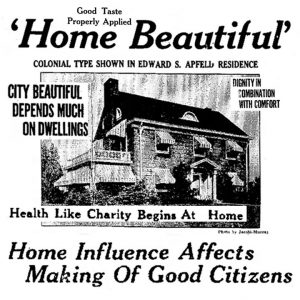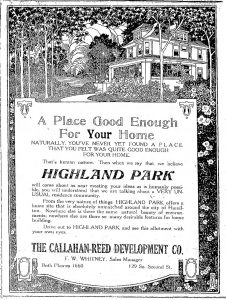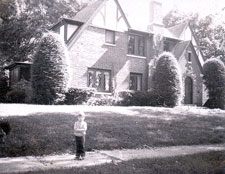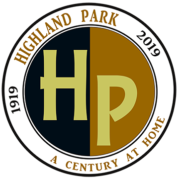
Home Beautiful
These days, home is more important than ever.
When people think about Highland Park, they think about beautiful homes. This high regard is no accident. The developers and original home-owners of Highland Park embraced the virtues of the Home Beautiful movement.

The Home Beautiful movement of the Twenties and Thirties believed that building handsome houses in pretty settings encouraged good citizenship, inspired refinement, nurtured good character, and created a sense of well-being for the families who lived in them. Even the President of the United States got into the act. In 1923, President Warren Harding declared, “[W]e seek to make better homes in order that we may avoid the necessity for conflict and turmoil in our world. The home is the apex and the aim, the end rather than the means of our whole social system.”

Heady stuff, and it worked. In 1919, the Highland Park developers chose farm and woodland far enough from the city to avoid the hustle and bustle, but close enough for convenience. They preserved the oldest trees, buried utilities underground, aimed Highland Park advertisements at the professional classes, and strongly suggested to customers what houses would be appropriate for Highland Park.
Early property owners turned to talented, local architects such as George Barkman and Frederick Mueller to build beautiful yet practical houses. On the outside, these houses reflected the unique tastes of their occupants. Highland Park homes were built in Tudor Revival, English Colonial Revival, Dutch Colonial Revival and Spanish Colonial Revival styles. Whether they realized it or not, Highland Park home owners paid homage to the diverse origins of the American dream.
On the inside, these first Highland Park homes were family homes where the lady of the house could entertain the garden club just as easily as she could marshal her family through the daily routine. Conveniences such as a basement shower and toilet for the day-help, a gas-starter for the hearth, a clothes chute for laundry, central heating, and gracious floor plans made her achievement possible.
Often kitted out with a breakfast room in addition to a dining room, the Highland Park home encouraged the gathering of friends and family. So, too, did wide living rooms centered on a welcoming fireplace, sometimes flanked by a baby grand piano where practice was expected. Sunrooms, with their warm and breezy corners, were the leisure time reward made possible by talent and hard work.
Highland Park homes were well-built homes. Their designers often specified Rookwood tiles and the newest American Standard sanitary fixtures for snazzy, modern bathrooms. Baseboards and crown moldings finished off even menial rooms with a protective flair. Hardwood floors, oak doors, stone sills, leaded windows, even cedar closets indicated that Highland Homes were built for life, and that their families were here to stay.

Judged by any standard, the homes of Highland Park met the aspirations of the Home Beautiful movement. The Hamilton Daily News featured Highland houses time and again in its “Home Beautiful” section. Many of the first children Highland Park homes nurtured became prominent members of the community, even owners of their own Highland Park homes. The houses themselves have moved gracefully through time, collecting memories and spirit while creating an irreplaceable neighborhood aesthetic. They face the future with confidence. Highland Park homes are, as ever, homes worth having.
– Dave Duricy
